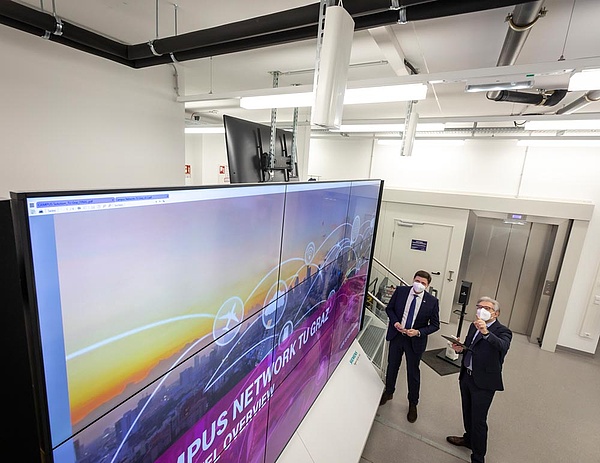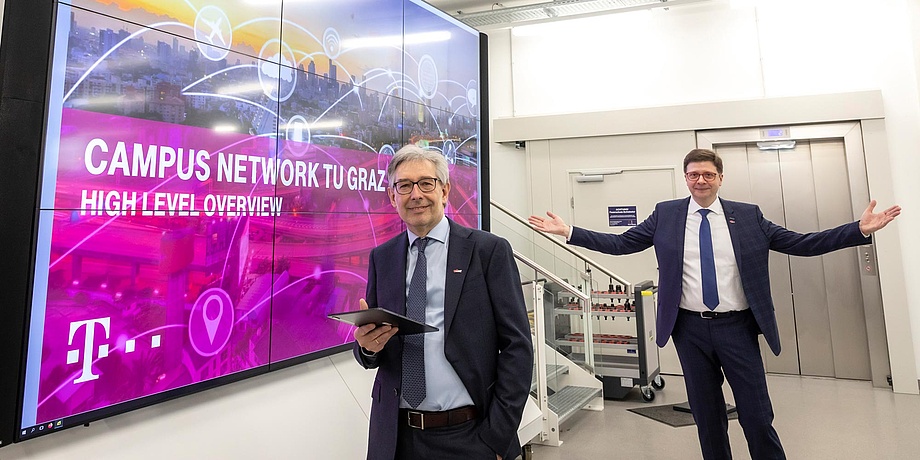Franz Haas lets his eyes wander through the experimental smartfactory@tugraz in Inffeldgasse, Graz. A lot has happened here in recent months – much more than the two new small antennas in the room would suggest, as the Dean of the Faculty of Mechanical Engineering explains: "Together with our partner, T-Mobile Austria GmbH, we have installed a fully-fledged, so-called Campus 5G network, which we will use for future research." The focus is on the topics of fast and secure data transmission, functional occupational safety, system reliability and innovative production and automation systems. "With the new 5G network, we see ourselves as an incubator for new application ideas and want to implement exciting projects with partner companies of all sizes and industries."
5G is the successor to the previous mobile communications standard 4G. Until now, a frequency range between 3 kHz and 6 GHz has been used for data transmission in mobile communications. 5G extends this range up to 300 GHz. This means that much more data can be transmitted in a much shorter time with significantly lower transmission power. This is particularly interesting for those areas where system-critical real-time data is generated in very large quantities, such as the Internet of Things, highly automated production and autonomous driving.

Franz Haas (l.) and Rudolf Pichler inspect the 5G antennas (above) in the smartfactory@tugraz pilot factory. © Lunghammer - TU Graz
Possible applications and new ideas
The possible applications are wide-ranging, as Franz Haas explains: "5G allows us to have data processed and sent in virtually real time. This can significantly increase safety in production facilities." For example, the new standard would be fast enough to instantly display hazard alerts to employees via data goggles they wear or to send emergency stop commands to machines in the event of critical faults. "Safety is and will remain in the future a key issue – 5G can make a big difference here," says the researcher.
In addition to safety, Haas sees significant development opportunities for machine vision. In a first project, employees are currently being equipped with data goggles in order to record production tools correctly, to be able to detect and avoid operating errors at an early stage, and to facilitate maintenance work. "At TU Graz in particular, image processing is a domain," notes Haas, referring to the Institute of Computer Graphics and Vision, for example.
And in the field of virtual and augmented reality, too, the new mobile communications standard is a door opener to new worlds. Designers can use headsets to immerse themselves directly in their designs and work on them "from the inside out" in the truest sense of the word. "Currently, data glasses can only do the rendering required for this with great effort due to their hardware restrictions. However, with the help of 5G technology, these large computing tasks could be transferred to a cloud that sends and receives the data to be processed in real time," Haas said. This leads to a completely new world of collaborative design of machines and entire factories.
On the subject of data security, a cooperation with the company SGS is in the offing. In February 2019, the world market leader in the field of testing, verification, inspection and certification of products, which also carries out IT security evaluations, together with TU Graz, initiated Cybersecurity Campus Graz which is located on Campus Inffeldgasse, in the direct vicinity of smartfactory@tugraz. "There have already been initial discussions and a strong commitment to work closely together," summarizes Haas.
The 5G network in smartfactory@tugraz was implemented together with the mobile communications provider T-Mobile Austria GmbH and with funding from the City of Graz, the Chamber of Commerce and the State of Styria.
Lowest radiation exposure
In addition to the many possible applications, a topic which has been widely discussed in public will be addressed: 5G and health. The short-wave radiation is much more susceptible to interference than the longer-wave radiation used so far and could be affected by stone walls or heavy rain. Therefore, considerably more transmitters will be necessary than before. However, these transmitters are also much smaller and operate at lower transmitting power than the current transmitters. This means the new transmitters will be closer to where people live. This raises concerns about health among parts of the public. Together with AUVA, Haas wants to investigate the radiation exposure from 5G here in the long term. "In particular, we will look at how different transmission power levels of antennas affect each other. It's also interesting to note that the large number of transmitters means that transmitters not currently in full use can be switched off or operated in a reduced mode, resulting in even lower overall radiation exposure than before."
Conducting research together and shaping the future
Rudolf Pichler, head of the smartfactory@tugraz pilot factory, and Franz Haas are now inviting companies of all sectors and sizes to contact them. "We want to work with them to define innovative ideas on projects related to 5G applications and enable a transfer of this new technology into business reality. With our 5G campus network, we are pioneers across Austria and are leveraging experience from our partners at RWTH Aachen University and other locations."

